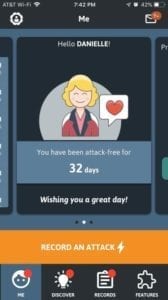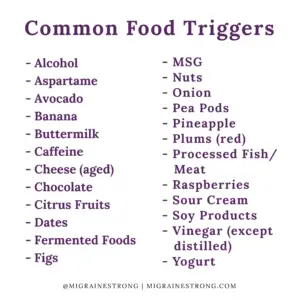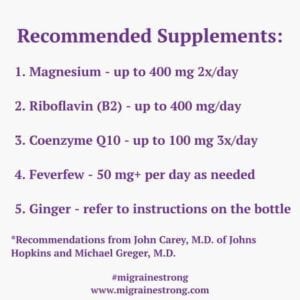There is so much I wish I knew about minimizing migraine when my frequency of attacks was ramping up a few years ago. I would have avoided “chronifying” and felt like myself rather than someone going through the motions in life for so long.
I assume you have episodic migraine that is worsening and you are here trying to figure out what to do to minimize the attacks. It’s gotten so bad that you can’t be the person that you once were and it’s sucking the life out of you so many days of the month.
You don’t know what’s worse – canceling commitments and looking like a flake or pushing through and pretending you are ok when you can barely think straight. In the back of your mind you think, “Could this get worse?”
Maybe you don’t want to go to see your doctor or specialist again and you want to know what can be done right now to get better. Or you have been to see your doctor and feel reluctant to fill the prescribed daily migraine medication. This is not medical advice. The tips below can help you get better, along side the help you get from your doctor, and start minimizing your migraine attacks.
** While Migraine Strong writes about the latest in migraine treatments, this is not medical advice. We are patient educators and all information you read should be discussed with your doctor.
Things I know now but wish I knew then…
Medications – A love/hate relationship
If you haven’t already done so, please read my blog about episodic migraine and medications. Understanding the role of migraine meds as well as others you may take is very important. Implementing the steps from that one blog may help you tremendously.
The Personal Plan to Roll-Back Attacks detailed in the blog may take a few weeks for you to implement if you take those prescribed and over-the-counter medications. The effort will be worth it. Medications can provide wonderful relief when properly taken. I wish I knew that the the medications that were helping me live my life and ditch my increasing migraine attacks ultimately hurt me. The good news is that now that my migraine attack frequency has diminished, they help me again.
Migraine Strong recently interviewed a migraine expert about keeping migraine attack frequency from moving from episodic to chronic. Her tips for helping to get chronic migraine back to episodic migraine will help many who are trying to find the right combination of medications and other interventions.
Next, take a good look at what you think your triggers are.
Triggers are Tricky.
What makes triggers so tricky is that they tend to be cumulative. That is, they stack on top of each other. A stressful day may not trigger you, but a stressful day after a lousy night of sleep, on a stormy day that you capped off with a glass of red wine may do you in! This eye-opening blog from Eileen Zollinger discusses this concept in more detail and may help you understand your personal trigger threshold.
The internet will provide you with conflicting lists of the most common migraine triggers and they will rank them differently. Stress is usually at the top followed by poor sleep. Weather, hormones, diet, hydration, scents, lighting, alcohol and caffeine are also common triggers. How each rank with an individual will vary.
How do you figure out your personal triggers? My favorite way is to use a popular tracker called Migraine Buddy. It’s a popular smartphone app as it’s easy to use and is frequently updated to help the user figure out what’s helping and what’s hurting. I wish I knew about Migraine Buddy when things were so bad.

** IMPORTANT – If you are in a phase where it seems like “everything is a trigger,” it’s likely the time to up your migraine preventive game with help from your doctor’s prescription pad or a neuromodulation device. Most people only have a few triggers. If your migraine brain is over-responding “to everything,” it’s not likely that you can “lifestyle your way to wellness.”
The MOST Controllable Triggers – Caffeine, Foods and Beverages
Caffeine – I know, I know- Many of you are wincing right now. Questions about coffee and migraine come up all the time, but significant caffeine sources are in other, less obvious places. This blog called Caffeine and Migraine- Trigger or Treatment and it is a must-read. I have 2 strong recommendations for you:
- Note your caffeinated beverage intake and notice if your attacks tend to happen when you deviate from your pattern. Some patterns I have seen that cause trouble – Varying amounts of caffeinated coffee, tea and/or soda due to weekend/weekday habits. Out of town travel is also a common problem as it interrupts the usual morning routine. Notice if you tend to feel fine when having your usual number of caffeinated beverages but start getting symptoms after you have the extra serving while at a mid-morning meeting or spontaneous trip through a drive-thru.
- Read ingredient labels. Is that smoothie that you love so much made with caffeine? How about that powdered drink that you have occasionally? Are you drinking energy drinks or taking supplements to boost your energy? Caffeine may be an ingredient. The inconsistent amount or having too much caffeine may be triggering you. Inconsistency of caffeine intake makes minimizing your migraine attacks more difficult.
Caffeine In Medications
Caffeine is an important part of some over-the-counter (OTC) and prescribed medications and is part of why the medication works so well. The OTC medication that you take for joint pain may get its boost from caffeine. Check out those labels, too.
Why is caffeine a potential problem? One reason it might be a problem for you is that your body may be used to a steady amount and when it varies, it can trigger an attack.
The migraine brain tends to over-respond to things that a non-migraine brain doesn’t notice. It’s also possible that you have a specific sensitivity to caffeine and will be triggered by high amounts of it.
Perhaps the worst way caffeine can hurt us is by disrupting our sleep. Many people unknowingly consume caffeine late in the day and it disrupts healthy sleep. Since stress and poor sleep are the most common migraine triggers, we spend a lot of time discussing caffeine and encourage people to limit it. Many headache specialists discourage caffeine use except when used regularly and no more than 200 mg/day.
Recommendations for you-
- If you wish to reduce or eliminate caffeine, make sure to understand all the caffeine you typically have in a day. Then, gradually decrease your caffeine intake. Do not abruptly stop caffeine or you will likely trigger an attack. A goal of minimizing caffeine in your daily routine may allow you to use a strong cup of coffee or other caffeinated drink as an effective non-pharmaceutical abortive. It may be the only perk to having a migraine attack.
- If you cannot imagine your life without a little caffeine in the morning, keep the amount small and stop drinking it 10 hours before bedtime. Keep the timing and amount consistent each day. As said above, many headache specialists suggest keeping caffeine intake to less than 200 mg/day.
- Look for alternative pain relievers without caffeine to address pain elsewhere in your body. If you use Excedrin Migraine, Fioricet or Fiorinal and haven’t read this blog yet, please do. At the very least, avoid them in the evening. Ask your doctor or pharmacist for guidance.
Foods And Beverages
As a registered dietitian, my first instinct is to look to food as a potential solution to a problem. I believe that many people with frequent and chronic migraine can find some relief by identifying food triggers or shifting to a diet that causes less inflammation.
You may already know some of your food triggers. Maybe you notice the consistent searing head pain you get after eating or drinking the certain foods or drink. Perhaps you made the connection between your visits to Costco when you get the big canister of chocolate covered almonds and a huge wedge of aged cheese and have an uptick in attacks. For many people, the best way of identifying food triggers is by an avoidance diet or a migraine-oriented elimination diet.
Avoidance Vs. Elimination Diets
An avoidance diet is much easier to do than a full elimination diet as it restricts fewer foods. With an avoidance diet, you pick a small group of foods that are known to be common migraine triggers and avoid them for a several weeks. Then you see if your attack frequency has improved. With an elimination diet you shift to eating only foods that are commonly considered “safe” or “head-friendly.”
Below is a list of foods that are widely considered common migraine triggers:

Avoidance Diet
Someone trying an avoidance diet might choose to stay away from avocado, banana and yogurt for enough time to see if they notice a minimizing effect on their migraine attacks. Obviously, the time frame would have to cover enough weeks to notice a difference. If there is no obvious difference, use a different group of foods.
This process often helps people identify a couple of their triggers as often people already have some suspicions. However, trying different combinations may never yield results as you may never choose the right combination. Usually, people who say “I have no food triggers” have used an avoidance diet so they cannot be sure.
Elimination Diet
For an elimination diet, the person eliminates the list of foods considered common triggers and eats only foods that are considered commonly “safe” or “head-friendly.” At first glance, you might say, “What’s left? A bowl of ice??” The list is long, but there is a much longer list of foods that are wholesome, healthy and delicious, too. Here is a link to help you relax and breathe easier with practical help to get you started on a popular migraine oriented elimination diet.
There is no hard and fast rule about who should try an avoidance diet and who should try an elimination diet. I think if your attack pattern is usually 0-2 per week, you may have success by tracking your suspected foods in a smartphone app like Migraine Buddy (or similar) and doing an avoidance diet. If your attack frequency is higher than that, you may get better and faster results by tracking your suspected triggers in an app and doing a migraine-oriented elimination diet like Heal Your Headache (HYH) or the Charleston Diet. In this blog, Jennifer Bragdon shares her experience with HYH.
What we put in our mouths is totally under our control. It’s really great when we can figure out some food triggers and have success minimizing some migraine attacks. Not everyone has food triggers but I believe many of us do and trying to figure them out is worthwhile. I wish I had known that the delicious, nutritious, wholesome foods that I thought were good for me were constantly triggering my attacks. Eating “healthy” may not help your head if those healthy foods are your triggers.
On the other hand, some people take it too far when trying to find food triggers. Those with a history of disordered eating should not try an avoidance diet or elimination diet. Always check with your doctor to determine if a restrictive diet is safe for you.
Hydration
Staying well-hydrated is another factor that is completely within your control. You may be like me. I don’t like drinking, in general. Unless I’m warm, I do not like water.
It’s probably not likely that merely having a low-fluid day would trigger a migraine for you, but being dehydrated on top of other factors is “filling your Bucket” and may bring about a full migraine attack. If you know you tend to not drink enough fluids, challenge yourself to figure out ways you can overcome this.
Sleep
If you ask neurologists and those that specialize in migraine what lifestyle issue they wish their patients should prioritize most to continue minimizing migraine attacks, most will put sleep and reducing stress at the top of the list. Sleep is when our nervous system resets itself. It’s when the brain “takes out the trash” so the next day we can start fresh.
Quality sleep is so very important. It’s also entwined with stress. A person with high stress may not sleep well. A person with poor sleep may not cope as well with everyday issues and feel more stressed. It’s a viscous circle. I had a young child when my head was at it’s worst, but had I known how much of a role sleep was, I would have asked for help and done things differently.
Quality sleep must be a priority to help prevent migraine attacks. Jenn wrote an excellent blog about sleep to help you more.
Supplements
There are supplements that have good studies supporting their use in migraine. Some of the more thorough general neurologists and headache specialists advise their patients to take specific supplements to get attacks under better control. This list below is a handy reference on what is recommended. I wish I had known how much the right type of magnesium would have helped me as I had tried and failed with the wrong type.

What you can do right away
These are actions you can take immediately to help yourself:
- Understand the good and bad about prescribed and OTC medications.
- If you aren’t seeing a migraine expert, consider upgrading your care.
- Take the right supplements after consulting with your doctor.
- Figure out triggers and focus on the most controllable ones.
- Prioritize sleep.
- Prioritize stress reduction.
- Stay hydrated to help prevent attacks.
Keep in mind that migraine is a neurological disorder. The migraine brain is different than a typical brain. It over-responds to normal stimulation. You are not the cause of migraine. You can do all of the above interventions and still have many attacks. Some of us need one or more medications to get attacks in good control. This should not dissuade you from trying to figure out how you can prevent attacks and help medications to be more effective.
This blog has been updated and refreshed from it’s original publication date.
